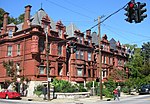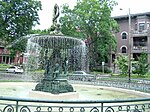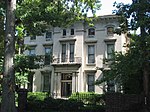Louisville sewer explosions
On February 13, 1981, a series of explosions destroyed more than 13 miles (21 km) of sewer lines and streets in the center of Louisville in Kentucky, United States. The explosions resulted in extensive damage to property and infrastructure; there were no fatalities, but four people were injured.The blasts were caused by the ignition of hexane vapors which had been illegally discharged from a soybean processing plant owned by Ralston-Purina and located on Floyd Street. The plant had been a processing facility for cottonseed or soybeans since at least 1900.Repairs to the sewers and streets took about two years. Ralston-Purina paid $18 million to the Louisville Metropolitan Sewer District, about $9 million to about 17,000 plaintiffs in a lawsuit settled in 1984, $4 million to the city, and $2 million to affected members of the public that did not sue the company. The company admitted that it had released hexane into the sewers, but initially did not accept responsibility for the blasts and continued to deny negligence for years until eventually pleading guilty to four counts of violating federal environmental laws and paying the maximum possible fine, $62,500.
Excerpt from the Wikipedia article Louisville sewer explosions (License: CC BY-SA 3.0, Authors).Louisville sewer explosions
South 12th Street, Louisville
Geographical coordinates (GPS) Address Nearby Places Show on map
Geographical coordinates (GPS)
| Latitude | Longitude |
|---|---|
| N 38.227416666667 ° | E -85.775166666667 ° |
Address
South 12th Street 1500
40210 Louisville
Kentucky, United States
Open on Google Maps




